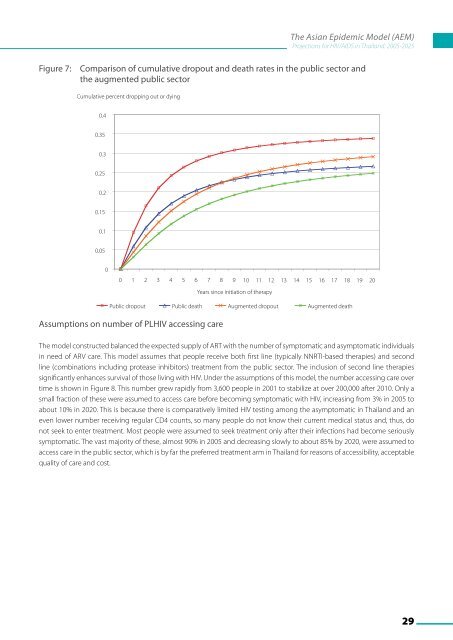The Asian Epidemic Model (AEM) Projections for ... - AIDS Data Hub
The Asian Epidemic Model (AEM) Projections for ... - AIDS Data Hub
The Asian Epidemic Model (AEM) Projections for ... - AIDS Data Hub
You also want an ePaper? Increase the reach of your titles
YUMPU automatically turns print PDFs into web optimized ePapers that Google loves.
<strong>The</strong> <strong>Asian</strong> <strong>Epidemic</strong> <strong>Model</strong> (<strong>AEM</strong>)<strong>Projections</strong> <strong>for</strong> HIV/<strong>AIDS</strong> in Thailand: 2005-2025Figure 7:Comparison of cumulative dropout and death rates in the public sector andthe augmented public sectorAssumptions on number of PLHIV accessing care<strong>The</strong> model constructed balanced the expected supply of ART with the number of symptomatic and asymptomatic individualsin need of ARV care. This model assumes that people receive both first line (typically NNRTI-based therapies) and secondline (combinations including protease inhibitors) treatment from the public sector. <strong>The</strong> inclusion of second line therapiessignificantly enhances survival of those living with HIV. Under the assumptions of this model, the number accessing care overtime is shown in Figure 8. This number grew rapidly from 3,600 people in 2001 to stabilize at over 200,000 after 2010. Only asmall fraction of these were assumed to access care be<strong>for</strong>e becoming symptomatic with HIV, increasing from 3% in 2005 toabout 10% in 2020. This is because there is comparatively limited HIV testing among the asymptomatic in Thailand and aneven lower number receiving regular CD4 counts, so many people do not know their current medical status and, thus, donot seek to enter treatment. Most people were assumed to seek treatment only after their infections had become seriouslysymptomatic. <strong>The</strong> vast majority of these, almost 90% in 2005 and decreasing slowly to about 85% by 2020, were assumed toaccess care in the public sector, which is by far the preferred treatment arm in Thailand <strong>for</strong> reasons of accessibility, acceptablequality of care and cost.29















